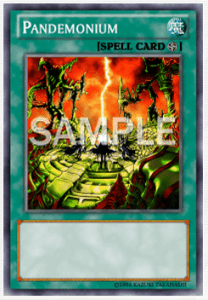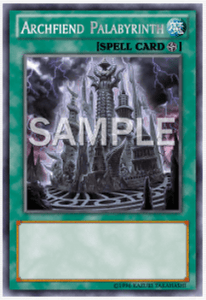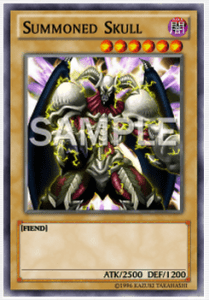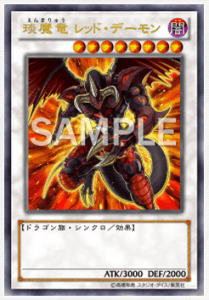Introducing the archetype that holds a special place in my heart, the Chess Daemons! I’m positive you’ve heard of these little fiends before, I mean, who hasn’t? Introducing the only archetype to include multiple cards without the archetype name in their title, in addition to being one of the handful of archtypes released in the TCG to span across all 4 YGO animes! So if you are completely unaware of their power, it’s time to crawl out from under your rock and join this game of chess!

History:
The Archfiends have been around since the early days of Yu-Gi-Oh. In fact, the archetype debuted it in both the first 2 Starter Decks, Yugi & Kaiba, AND the second booster pack, Metal Raiders. If you want to be technical with me, they were not released originally as Archfiends; however, they are classified as such now! If you want to be specific, the original ‘Archfiend’ archetype began back in Dark Crisis alongside the ‘Guardian’ archetype! There were 6 original Archfiends, and as most of you may know, the archetype was thematically based from the game of Chess, as each Archfiend was based on a different chess piece.
Terrorking Archfiend was the original leader of the chess archfiends, leading the army of Fiend-type monsters with various attributes that all had some element of luck, by relying upon a roll of the die to attempt to negate a targeting card effect! However, there was another shared effect by all of the early archfiends: maintenance costs. Boy, were those LP costs annoying, just lowering your LP during each of your Standby Phases. But then, every die-hard Archfiend player discovered the power of the Field Spell, Pandemonium (and no, it doesn’t have anything to do with Pandas, sadly…). This Field Spell removes the maintenance costs from Archfiend monsters, in addition to adding an Archfiend to your hand that has a lower Level than that of an Archfiend that was just destroyed by a card effect. The power of this Field Spell is not to be taken lightly, as we will be returning to it later.

Then came the drought, as no classified or named archfiends were released other than the useless Cyber Archfiend. And then, Konami decided to throw a bone to some of the old Field-Spells: Monster tutors in the pack Force of the Breaker! 6 tutors in total were released, among those 6 were Harpie’s Queen and Gravekeeper’s Commandment, and as a result, the poor Archfiend General was destined to be ignored. This pack also marked the beginning of the newer ‘Archfiend’ appearance with the official TCG release of the cards originally released in the skipped DARK Virus Structure Deck, which happened to include Mist Archfiend. From a series of armored chess pieces came an archetype of bony horrors from the pits of your worst nightmares.
Over the rest of recent history, the archetype kept getting these random additions that really didn’t synergize with any of the original or classified Archfiends, resulting in a type of techs and useless filler cards, such as Trance Archfiend or Archfiend Interceptor. However, it was near the end of this 5D’s era in which the most recent wave of Archfiend support arrived. Featured in Starstrike Blast, Archfiend Empress marked the beginning of a new glorious age of Archfiends, and it wasn’t until Judgement of the Light that the newer arc of amazing Archfiends came to its fruition. With it came a slew of new, powerful Archfiends with a brand new Field Spell, Archfiend Palabyrinth, which can hold their own exceptionally well through Xyz Summoning and Special Summoning powerful attackers on a whim!
A Dual Strategy:
Earlier in this article, I mentioned that there really is 2 forms for an Archfiend deck: one that uses Pandemonium and one that uses Archfiend Palabyrinth. This article will be focusing on the second build. There is definitely merits in both; however, I feel that the Pandemonium build is more straightforward and therefore less equipped to deal with a varying meta-game. Without further ado, let’s jump right into a Palabyrinth build!
Strategy:

The main concept of an Archfiend deck has definitely evolved since its older days; however, I am a steadfast believer that this evolution’s main purpose was to promote the older playstyle of the original Archfiends into a much faster and more powerful metagame. If you look back at the old Archfiends, a lot of them had stellar stats for fairly weak monsters. Throw in the fact that they have their own Special Summoning trap in the form of Archfiend Roar, and you have yourself a recipe for a nice beatstick-driven archetype. Hence, the new Field Spell, pictured above, captures that essence perfectly.
With ease of summoning of many high-leveled Fiends, the new-age Archfiends have power; quite a bit of it, in fact. With Archfiend Emperor, the First Lord of Horror, the deck is able to summon a Level 8 monster without Tribute that has the ability to destroy any card on the field for free… Yeah, that’s a nice quality for the small cost of banishing an Archfiend *card* (Roar and a dead Palabyrinth are great fodder). Following right behind is Archfiend Commander, a Level 6 monster that can be Special Summoned when you control an Archfiend, as long as you destroy an Archfiend *card* as soon as it is Special Summoned. Or if you choose to go the old route, you can Tribute Summon him and use his second effect to Special Summon back a fallen Commander or even the brand new Level 6 Archfiend Giant. The power of this new age variant does not come in summoning a single beatstick monster, as the Dragon Rulers can easily outdo that: their power comes from the ability to spring power out of left field like no one’s business!
Take for example, the combo potential of Summoning Archfiend Cavalry, Special Summoning Archfiend Commander, then destroying Cavalry with his effect. Calvary will then trigger, Special Summoning any Archfiend you need for the situation from the Graveyard. Special back a Level 6 for an easy Rank 6 Xyz Summon, or heck, bring back a Emperor for a easy destruction: the choice is yours. Also, who could discuss the massive updates to this archetype without touching upon the wonder of a search monster, Archfiend Heiress. Once per turn, when she is sent to the Graveyard by battle or an effect, you get to add an Archfiend card from the deck to the hand. Need I remind you of the power of Tour Guide from the Underworld and her love for other Level 3 Fiends? Or perhaps I should direct your attention to Trance Archfiend, a monster most notable for his contributions to the Dark World strategy. The new Archfiend deck is all about combos, and generally you have a variety of choices to choose from each turn. This versatility allows for the new-age Archfiends to adapt to the match-up, allowing for quite a showing from one of the original archetypes!
Core Lineup for a Palabyrinth Variant:
2|3 indicates that 2 or 3 copies should be considered.
Monsters:
- 3 Archfiend Heiress
- 3 Archfiend Emperor, the First Lord of Horror
- 2|3 Archfiend Cavalry
- 0|3 Archfiend Commander
- 0|1 Archfiend Giant
- 2 Trance Archfiend
- 2 Tour Guide from the Underworld
- 2|3 Battle Fader
Spells:
- 3 Archfiend Palabyrinth
- 2 Falling Down
- 1 Foolish Burial
Traps:
- 2 Archfiend Roar
- 0|2 Sinister Yokoshiro
This core lineup is centered around having a wide array of combinations available to you. Some Archfiend duelists prefer to avoid the whole Commander/Giant/Yokoshiro combinations entirely and choose to focus on Calvary, Heiress, and Emperor, and that is perfectly fine. The deck is yours to modify; I’ve just grown to prefer the Commander build as of late. As to the perplexed looks on your faces that I’m sure arose at the sight of Battle Fader on the list of core components, no, that was no mistake. Fader allows for an insane amount of plays with Palabyrinth simply because it is a Fiend-Type monster that generally will survive until your next turn. Drop Fader to stop an opponent’s push, then summon ANY Archfiend you like while controlling your beloved Field Spell. Use the Field Spell to exchange the used Fader to bring out any Archfiend of the same Level from your deck. That means, summon an Emperor, destroy an opponent’s card, banish Fader for another Emperor, destroy another opponent’s card. YAY for free pluses! Then, you get to attack with a 3500 ATK beater and a 2000 ATK beater, but remember, you cannot Xyz Summon with Emperor, cause of his restriction. Simply imagine all the possibilities open to an Archfiend variant.

Possible Tech Choices:
Archfiend Empress: While this monster may not have been amazing upon its debut as a Sneak Preview Participation card, it certainly has more merit nowadays with the release of Palabyrinth and Emperor, since it is another Level 8 that can be Special Summoned by Palabyrinth. Her effect when destroyed is also amazing, simply due to the fact that it can bring back quite the variety of threats for your opponent to deal with.
Dark Armed Dragon: Any DARK deck with any sort of control over the Graveyard should be able to run DAD. Just in Archfiends, you generally do not require additional destruction because we have our Emperor.
End of Anubis: Don’t look at me like that, I’m serious. With Sinister Yokoshiro, he can be summoned without Tribute, and quite frankly his effect can be very good against certain decks. Also, don’t forget about that all important DEF stat, one that can be abused by the next tech option!
Masked Chameleon: Ah yes, definitely the best Tuner to be released in recent times. Without the above, it opens up access to Level 7 or 8 Synchros by using Heiress and Calvary respectively. If you do choose to run End of Anubis, you also get access to the generic Rank 10’s! And if your Fader gets sent to the Graveyard somehow, you can always Synchro for a Level 5.
Terrorking Archfiend: The king of chess surprisingly hasn’t been pushed outside the realm of possibility, simply because he is a Level 4 that shuts down effects, providing great combos with Calvary or Trance Archfiend using the Field Spell. Also, who doesn’t like keeping a piece of history in your deck?
Desrook Archfiend: And now’s the weird tech that most people give me a second look about. It is a LIGHT Level 3 Fiend, and that’s really all you need. Summon TGU, go into Desrook, Palab switch TGU for Heiress, overlay Rank 3 into Number 49: Fortune Tune or Wind-Up Zenmaines! When Heiress is detached to prevent the destruction of either, you still get the search, and following that, when Desrook is detached, you just got yourself a nice setup in the Graveyard for a Chaos monster! Chaos Archfiends is a completely separate build, but it is an option that you can consider!
Infernity Archfiend: Yes, you can combine the Field Spell with a mini-Infernity engine! I cannot attest to its validity, but the build has been tested and tried quite a bit since the reveal of Palabyrinth!
Skill Drain: Hmpf, now this is a controversial option for me. It works really well to get rid of the ATK loss side effect of Summoning Emperor without tribute, but you also lose out on his powerful destruction effect! If you want to run drain, be my guest, just be aware that Skill Drain is only worth it if it hurts the opponent more than you!
Eradicator Epidemic Virus | Deck Devastation Virus: The viruses are *awesome* techs in Archfiends. Palabyrinth boots most Archfiends above the 2000 ATK threshold, and you have a variety of monsters that can get above 2500 ATK as well. These two traps are really good at completely eliminating any or all hope from certain decks; however, they do tend to lead to more bad hands since Archfiends are such a combo-reliant deck.
Completed Example Decklist:
For those of you who have suffered through this perilous article based off of an archetype that grew from an embodiment of the famous board game of wits and strategy, well, you’ve gained the prize of seeing an example build for this new-age Archfiend Strategy. As always, I know that the following may not be the best build for them, it is simply a starting point for your own creative deckbuilding endeavors: http://i.imgur.com/p5ahbqt.png
Enjoy the deck, and may your Fiends remain ever evil!
—-The Red Dragon Shall Rise—-
Bones Assemble, Daemons Unbound
Descend Upon The Mortals;
Unleash Your Power,
Guide Your Army.
As Night Breaks To Day,
Let Not Fate Define Your Way,
Battle Ever Gnarly
At That Fateful Hour:
Open All Portals;
Your Emperor Will Be Crowned.
Prepare for your Demise!


